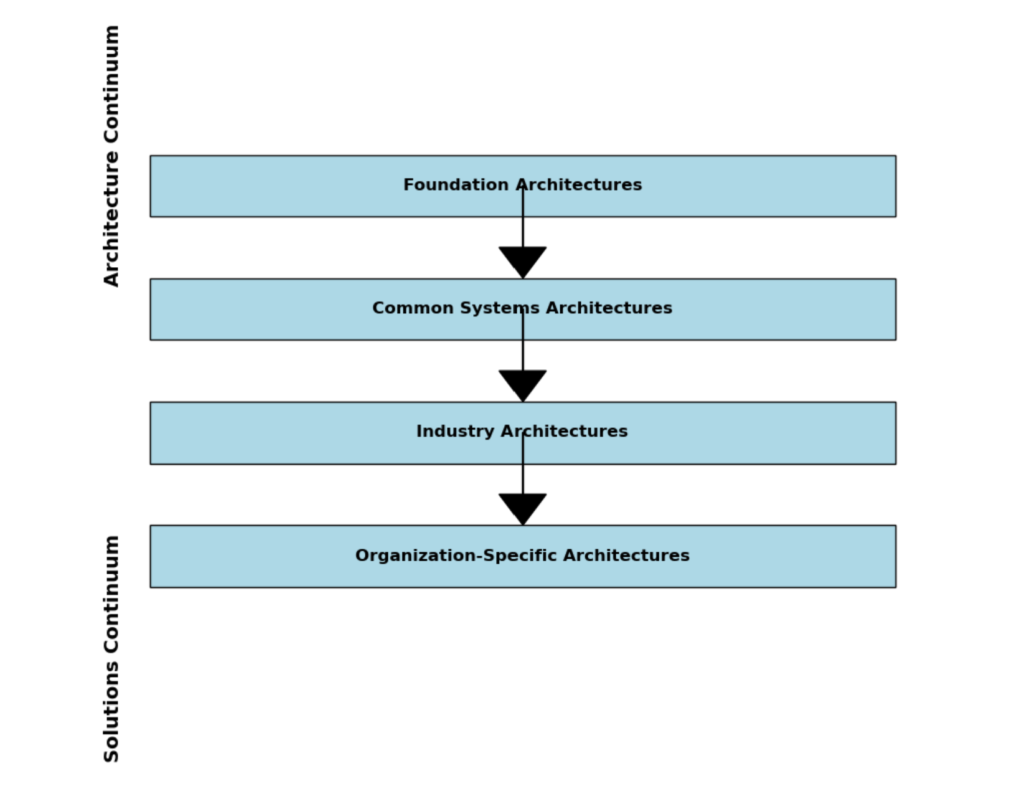The Enterprise Continuum
In enterprise architecture, one size rarely fits all. Organizations need a way to adapt architectural assets to their unique needs while still leveraging industry standards and best practices. TOGAF addresses this challenge through the concept of the Enterprise Continuum—a powerful model for organizing and evolving architectural assets.
🧱 What is the Enterprise Continuum?
The Enterprise Continuum is a classification mechanism in TOGAF that helps architects understand and manage the evolution of architecture assets. It spans from generic, foundational architectures to highly specific, organization-tailored solutions.
It consists of two key parts:
- Architecture Continuum: Describes the progression of architectural models from abstract to concrete.
- Solutions Continuum: Describes the implementation of those models in real-world solutions.
🧩 Visualizing the Enterprise Continuum
Here’s a diagram that illustrates the structure of the Enterprise Continuum:

This diagram shows how architecture evolves from Foundation Architectures to Organization-Specific Architectures, with the Architecture Continuum guiding the design and the Solutions Continuum guiding implementation.
🔍 Key Layers of the Continuum
1. Foundation Architectures
- Generic building blocks and standards (e.g., TCP/IP, identity management).
- Often provided by vendors or open standards bodies.
2. Common Systems Architectures
- Reusable services and platforms (e.g., enterprise service bus, cloud platforms).
- Provide solutions to common problems across industries.
3. Industry Architectures
- Tailored to specific sectors (e.g., banking, healthcare, manufacturing).
- Include regulatory compliance, industry-specific data models, etc.
4. Organization-Specific Architectures
- Customized to meet the unique needs of a specific enterprise.
- Includes internal processes, proprietary systems, and strategic goals.
✅ Real-World Example 1: Global Retail Chain
Foundation Architecture
- Uses standard cloud infrastructure (e.g., AWS, Azure).
- Implements global identity and access management.
Common Systems Architecture
- Deploys a shared e-commerce platform across regions.
- Integrates with payment gateways and logistics APIs.
Industry Architecture
- Adopts retail-specific data models (e.g., product catalogs, inventory).
- Complies with PCI-DSS for payment security.
Organization-Specific Architecture
- Custom loyalty program, regional pricing engines, and in-store kiosk systems.
✅ Real-World Example 2: National Healthcare Network
Foundation Architecture
- Uses open standards like HL7 and FHIR for health data exchange.
Common Systems Architecture
- Implements a national patient ID system and secure messaging.
Industry Architecture
- Aligns with healthcare regulations (e.g., HIPAA, GDPR).
- Includes templates for EHR systems and telemedicine platforms.
Organization-Specific Architecture
- Custom workflows for hospitals, clinics, and insurance providers.
- Integrated mobile apps for patients and doctors.
✅ Real-World Example 3: Government Digital Services
Foundation Architecture
- Leverages open-source platforms and national cloud infrastructure.
Common Systems Architecture
- Shared authentication and citizen identity services.
Industry Architecture
- Public sector frameworks for digital governance and service delivery.
Organization-Specific Architecture
- Custom portals for tax, licensing, and public records.
📝 Summary
The Enterprise Continuum in TOGAF provides a structured way to evolve and classify architectural assets—from foundational standards to organization-specific solutions. It empowers enterprises to reuse proven models, adapt to industry needs, and build architectures that are both robust and flexible. Whether you’re in retail, healthcare, or government, the Enterprise Continuum helps you bridge the gap between theory and implementation.